注意
點選此處下載完整示例程式碼
Torchaudio-Squim: TorchAudio 中的非侵入式語音評估¶
1. 概述¶
本教程展示瞭如何使用 Torchaudio-Squim 估計客觀和主觀指標,用於評估語音質量和可懂度。
TorchAudio-Squim 在 Torchaudio 中提供了語音評估功能。它提供介面和預訓練模型,用於估計各種語音質量和可懂度指標。目前,Torchaudio-Squim [1] 支援對 3 個廣泛使用的客觀指標進行無參考估計:
Wideband Perceptual Estimation of Speech Quality (PESQ) [2](寬頻感知語音質量評估)
Short-Time Objective Intelligibility (STOI) [3](短時客觀可懂度)
Scale-Invariant Signal-to-Distortion Ratio (SI-SDR) [4](尺度不變訊號失真比)
它還支援使用非匹配參考 (Non-Matching References) [1, 5] 估計給定音訊波形的主觀平均主觀意見得分 (MOS)。
參考
[1] Kumar, Anurag, et al. “TorchAudio-Squim: Reference-less Speech Quality and Intelligibility measures in TorchAudio.” ICASSP 2023-2023 IEEE International Conference on Acoustics, Speech and Signal Processing (ICASSP). IEEE, 2023.
[2] I. Rec, “P.862.2: Wideband extension to recommendation P.862 for the assessment of wideband telephone networks and speech codecs,” International Telecommunication Union, CH–Geneva, 2005.
[3] Taal, C. H., Hendriks, R. C., Heusdens, R., & Jensen, J. (2010, March). A short-time objective intelligibility measure for time-frequency weighted noisy speech. In 2010 IEEE international conference on acoustics, speech and signal processing (pp. 4214-4217). IEEE.
[4] Le Roux, Jonathan, et al. “SDR–half-baked or well done?.” ICASSP 2019-2019 IEEE International Conference on Acoustics, Speech and Signal Processing (ICASSP). IEEE, 2019.
[5] Manocha, Pranay, and Anurag Kumar. “Speech quality assessment through MOS using non-matching references.” Interspeech, 2022.
import torch
import torchaudio
print(torch.__version__)
print(torchaudio.__version__)
2.7.0
2.7.0
2. 準備工作¶
首先匯入模組並定義輔助函式。
我們將需要 torch、torchaudio 來使用 Torchaudio-squim,Matplotlib 用於繪圖,pystoi、pesq 用於計算參考指標。
try:
from pesq import pesq
from pystoi import stoi
from torchaudio.pipelines import SQUIM_OBJECTIVE, SQUIM_SUBJECTIVE
except ImportError:
try:
import google.colab # noqa: F401
print(
"""
To enable running this notebook in Google Colab, install nightly
torch and torchaudio builds by adding the following code block to the top
of the notebook before running it:
!pip3 uninstall -y torch torchvision torchaudio
!pip3 install --pre torch torchvision torchaudio --extra-index-url https://download.pytorch.org/whl/nightly/cpu
!pip3 install pesq
!pip3 install pystoi
"""
)
except Exception:
pass
raise
import matplotlib.pyplot as plt
import torchaudio.functional as F
from IPython.display import Audio
from torchaudio.utils import download_asset
def si_snr(estimate, reference, epsilon=1e-8):
estimate = estimate - estimate.mean()
reference = reference - reference.mean()
reference_pow = reference.pow(2).mean(axis=1, keepdim=True)
mix_pow = (estimate * reference).mean(axis=1, keepdim=True)
scale = mix_pow / (reference_pow + epsilon)
reference = scale * reference
error = estimate - reference
reference_pow = reference.pow(2)
error_pow = error.pow(2)
reference_pow = reference_pow.mean(axis=1)
error_pow = error_pow.mean(axis=1)
si_snr = 10 * torch.log10(reference_pow) - 10 * torch.log10(error_pow)
return si_snr.item()
def plot(waveform, title, sample_rate=16000):
wav_numpy = waveform.numpy()
sample_size = waveform.shape[1]
time_axis = torch.arange(0, sample_size) / sample_rate
figure, axes = plt.subplots(2, 1)
axes[0].plot(time_axis, wav_numpy[0], linewidth=1)
axes[0].grid(True)
axes[1].specgram(wav_numpy[0], Fs=sample_rate)
figure.suptitle(title)
3. 載入語音和噪聲樣本¶
SAMPLE_SPEECH = download_asset("tutorial-assets/Lab41-SRI-VOiCES-src-sp0307-ch127535-sg0042.wav")
SAMPLE_NOISE = download_asset("tutorial-assets/Lab41-SRI-VOiCES-rm1-babb-mc01-stu-clo.wav")
0%| | 0.00/156k [00:00<?, ?B/s]
100%|##########| 156k/156k [00:00<00:00, 65.3MB/s]
WAVEFORM_SPEECH, SAMPLE_RATE_SPEECH = torchaudio.load(SAMPLE_SPEECH)
WAVEFORM_NOISE, SAMPLE_RATE_NOISE = torchaudio.load(SAMPLE_NOISE)
WAVEFORM_NOISE = WAVEFORM_NOISE[0:1, :]
目前,Torchaudio-Squim 模型僅支援 16000 Hz 取樣率。如有必要,對波形進行重取樣。
if SAMPLE_RATE_SPEECH != 16000:
WAVEFORM_SPEECH = F.resample(WAVEFORM_SPEECH, SAMPLE_RATE_SPEECH, 16000)
if SAMPLE_RATE_NOISE != 16000:
WAVEFORM_NOISE = F.resample(WAVEFORM_NOISE, SAMPLE_RATE_NOISE, 16000)
修剪波形,使其具有相同數量的幀。
if WAVEFORM_SPEECH.shape[1] < WAVEFORM_NOISE.shape[1]:
WAVEFORM_NOISE = WAVEFORM_NOISE[:, : WAVEFORM_SPEECH.shape[1]]
else:
WAVEFORM_SPEECH = WAVEFORM_SPEECH[:, : WAVEFORM_NOISE.shape[1]]
播放語音樣本
Audio(WAVEFORM_SPEECH.numpy()[0], rate=16000)
播放噪聲樣本
Audio(WAVEFORM_NOISE.numpy()[0], rate=16000)
4. 建立失真(帶噪)語音樣本¶
snr_dbs = torch.tensor([20, -5])
WAVEFORM_DISTORTED = F.add_noise(WAVEFORM_SPEECH, WAVEFORM_NOISE, snr_dbs)
播放信噪比為 20dB 的失真語音
Audio(WAVEFORM_DISTORTED.numpy()[0], rate=16000)
播放信噪比為 -5dB 的失真語音
Audio(WAVEFORM_DISTORTED.numpy()[1], rate=16000)
5. 視覺化波形¶
視覺化語音樣本
plot(WAVEFORM_SPEECH, "Clean Speech")
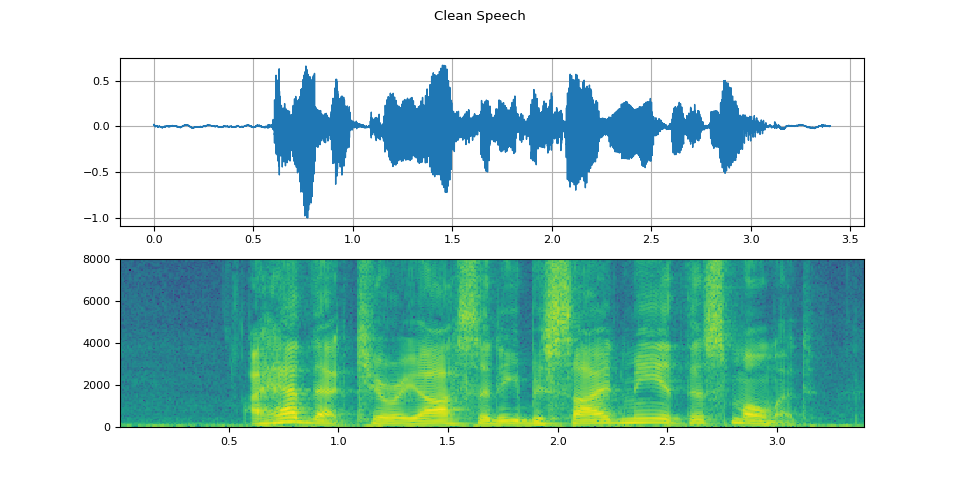
視覺化噪聲樣本
plot(WAVEFORM_NOISE, "Noise")
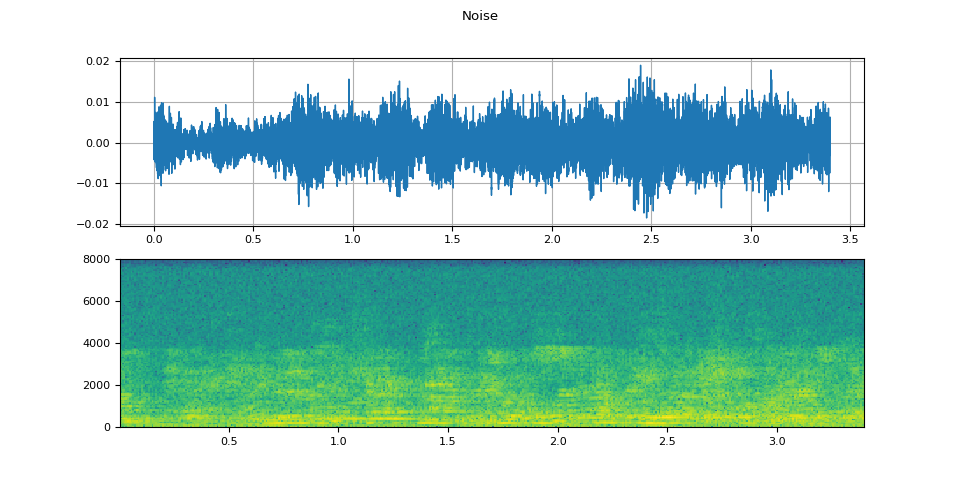
視覺化信噪比為 20dB 的失真語音
plot(WAVEFORM_DISTORTED[0:1], f"Distorted Speech with {snr_dbs[0]}dB SNR")
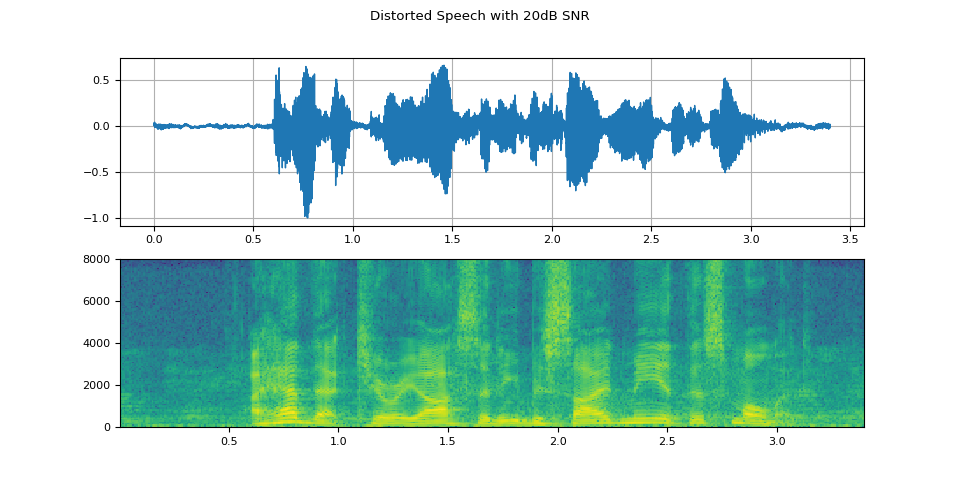
視覺化信噪比為 -5dB 的失真語音
plot(WAVEFORM_DISTORTED[1:2], f"Distorted Speech with {snr_dbs[1]}dB SNR")
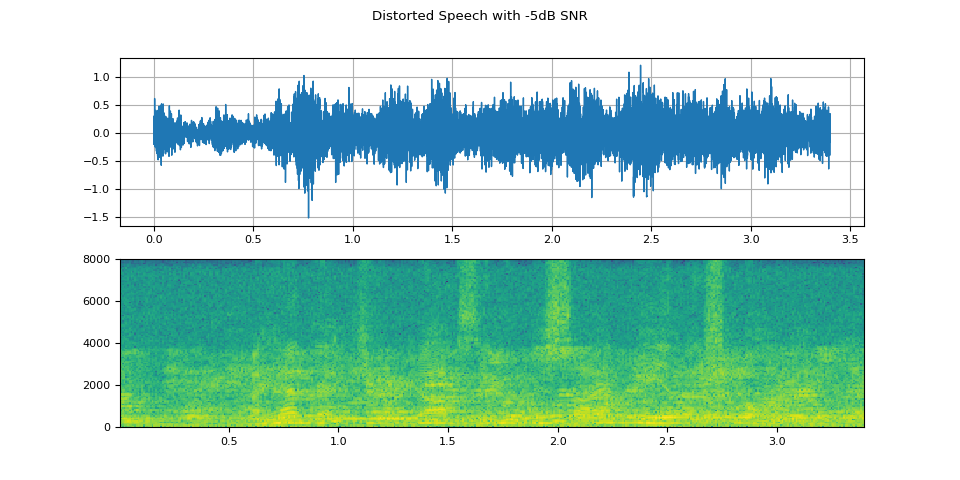
6. 預測客觀指標¶
獲取預訓練的 SquimObjective 模型。
objective_model = SQUIM_OBJECTIVE.get_model()
0%| | 0.00/28.2M [00:00<?, ?B/s]
52%|#####2 | 14.8M/28.2M [00:00<00:00, 27.7MB/s]
62%|######2 | 17.5M/28.2M [00:00<00:00, 22.5MB/s]
96%|#########5| 27.0M/28.2M [00:00<00:00, 31.0MB/s]
100%|##########| 28.2M/28.2M [00:00<00:00, 29.9MB/s]
將模型輸出與信噪比為 20dB 的失真語音的真實值進行比較
stoi_hyp, pesq_hyp, si_sdr_hyp = objective_model(WAVEFORM_DISTORTED[0:1, :])
print(f"Estimated metrics for distorted speech at {snr_dbs[0]}dB are\n")
print(f"STOI: {stoi_hyp[0]}")
print(f"PESQ: {pesq_hyp[0]}")
print(f"SI-SDR: {si_sdr_hyp[0]}\n")
pesq_ref = pesq(16000, WAVEFORM_SPEECH[0].numpy(), WAVEFORM_DISTORTED[0].numpy(), mode="wb")
stoi_ref = stoi(WAVEFORM_SPEECH[0].numpy(), WAVEFORM_DISTORTED[0].numpy(), 16000, extended=False)
si_sdr_ref = si_snr(WAVEFORM_DISTORTED[0:1], WAVEFORM_SPEECH)
print(f"Reference metrics for distorted speech at {snr_dbs[0]}dB are\n")
print(f"STOI: {stoi_ref}")
print(f"PESQ: {pesq_ref}")
print(f"SI-SDR: {si_sdr_ref}")
Estimated metrics for distorted speech at 20dB are
STOI: 0.9610356092453003
PESQ: 2.7801527976989746
SI-SDR: 20.692630767822266
Reference metrics for distorted speech at 20dB are
STOI: 0.9670831113894452
PESQ: 2.7961528301239014
SI-SDR: 19.998966217041016
將模型輸出與信噪比為 -5dB 的失真語音的真實值進行比較
stoi_hyp, pesq_hyp, si_sdr_hyp = objective_model(WAVEFORM_DISTORTED[1:2, :])
print(f"Estimated metrics for distorted speech at {snr_dbs[1]}dB are\n")
print(f"STOI: {stoi_hyp[0]}")
print(f"PESQ: {pesq_hyp[0]}")
print(f"SI-SDR: {si_sdr_hyp[0]}\n")
pesq_ref = pesq(16000, WAVEFORM_SPEECH[0].numpy(), WAVEFORM_DISTORTED[1].numpy(), mode="wb")
stoi_ref = stoi(WAVEFORM_SPEECH[0].numpy(), WAVEFORM_DISTORTED[1].numpy(), 16000, extended=False)
si_sdr_ref = si_snr(WAVEFORM_DISTORTED[1:2], WAVEFORM_SPEECH)
print(f"Reference metrics for distorted speech at {snr_dbs[1]}dB are\n")
print(f"STOI: {stoi_ref}")
print(f"PESQ: {pesq_ref}")
print(f"SI-SDR: {si_sdr_ref}")
Estimated metrics for distorted speech at -5dB are
STOI: 0.5743248462677002
PESQ: 1.1112866401672363
SI-SDR: -6.248741626739502
Reference metrics for distorted speech at -5dB are
STOI: 0.5848137931588825
PESQ: 1.0803768634796143
SI-SDR: -5.016279220581055
7. 預測平均主觀意見得分(主觀指標)¶
獲取預訓練的 SquimSubjective 模型。
subjective_model = SQUIM_SUBJECTIVE.get_model()
0%| | 0.00/360M [00:00<?, ?B/s]
1%| | 2.12M/360M [00:00<00:18, 19.8MB/s]
2%|1 | 6.38M/360M [00:00<00:13, 27.3MB/s]
2%|2 | 9.00M/360M [00:00<00:18, 19.6MB/s]
4%|3 | 12.8M/360M [00:00<00:16, 22.0MB/s]
5%|4 | 16.5M/360M [00:00<00:16, 22.2MB/s]
9%|8 | 31.1M/360M [00:01<00:09, 35.6MB/s]
10%|9 | 34.2M/360M [00:01<00:11, 29.1MB/s]
13%|#3 | 47.6M/360M [00:01<00:06, 47.3MB/s]
15%|#4 | 52.9M/360M [00:01<00:08, 38.3MB/s]
18%|#8 | 65.6M/360M [00:01<00:06, 48.0MB/s]
22%|##2 | 79.2M/360M [00:01<00:04, 65.3MB/s]
24%|##4 | 87.0M/360M [00:02<00:05, 48.9MB/s]
27%|##6 | 96.8M/360M [00:02<00:04, 55.9MB/s]
29%|##8 | 104M/360M [00:02<00:05, 49.8MB/s]
32%|###1 | 115M/360M [00:02<00:04, 55.5MB/s]
35%|###5 | 126M/360M [00:02<00:03, 68.5MB/s]
37%|###7 | 134M/360M [00:03<00:04, 50.8MB/s]
41%|#### | 146M/360M [00:03<00:03, 60.5MB/s]
42%|####2 | 153M/360M [00:03<00:04, 54.1MB/s]
45%|####5 | 164M/360M [00:03<00:03, 55.3MB/s]
48%|####8 | 174M/360M [00:03<00:02, 65.3MB/s]
50%|##### | 182M/360M [00:03<00:03, 54.2MB/s]
54%|#####4 | 195M/360M [00:04<00:03, 55.5MB/s]
56%|#####5 | 201M/360M [00:04<00:03, 49.3MB/s]
59%|#####8 | 211M/360M [00:04<00:02, 55.0MB/s]
60%|###### | 217M/360M [00:04<00:03, 48.8MB/s]
63%|######3 | 228M/360M [00:04<00:02, 59.4MB/s]
65%|######5 | 234M/360M [00:04<00:02, 56.1MB/s]
68%|######7 | 244M/360M [00:05<00:02, 59.7MB/s]
69%|######9 | 250M/360M [00:05<00:02, 55.5MB/s]
72%|#######2 | 260M/360M [00:05<00:01, 65.3MB/s]
74%|#######3 | 266M/360M [00:05<00:02, 45.0MB/s]
77%|#######6 | 277M/360M [00:05<00:01, 43.7MB/s]
78%|#######8 | 282M/360M [00:06<00:02, 32.2MB/s]
79%|#######9 | 286M/360M [00:06<00:02, 30.9MB/s]
82%|########1 | 294M/360M [00:06<00:01, 40.3MB/s]
83%|########3 | 300M/360M [00:06<00:01, 40.8MB/s]
86%|########6 | 311M/360M [00:06<00:01, 48.6MB/s]
91%|######### | 328M/360M [00:07<00:00, 59.7MB/s]
95%|#########5| 342M/360M [00:07<00:00, 67.7MB/s]
97%|#########6| 349M/360M [00:07<00:00, 59.4MB/s]
100%|#########9| 359M/360M [00:07<00:00, 66.7MB/s]
100%|##########| 360M/360M [00:07<00:00, 50.2MB/s]
載入非匹配參考 (NMR)
NMR_SPEECH = download_asset("tutorial-assets/ctc-decoding/1688-142285-0007.wav")
WAVEFORM_NMR, SAMPLE_RATE_NMR = torchaudio.load(NMR_SPEECH)
if SAMPLE_RATE_NMR != 16000:
WAVEFORM_NMR = F.resample(WAVEFORM_NMR, SAMPLE_RATE_NMR, 16000)
計算信噪比為 20dB 的失真語音的 MOS 指標
mos = subjective_model(WAVEFORM_DISTORTED[0:1, :], WAVEFORM_NMR)
print(f"Estimated MOS for distorted speech at {snr_dbs[0]}dB is MOS: {mos[0]}")
Estimated MOS for distorted speech at 20dB is MOS: 4.309267997741699
計算信噪比為 -5dB 的失真語音的 MOS 指標
mos = subjective_model(WAVEFORM_DISTORTED[1:2, :], WAVEFORM_NMR)
print(f"Estimated MOS for distorted speech at {snr_dbs[1]}dB is MOS: {mos[0]}")
Estimated MOS for distorted speech at -5dB is MOS: 3.291804075241089
8. 與真實值和基線進行比較¶
視覺化 SquimObjective 和 SquimSubjective 模型估計的指標,可以幫助使用者更好地理解這些模型在實際場景中的應用方式。下圖顯示了三種不同系統的散點圖:MOSA-Net [1]、AMSA [2] 和 SquimObjective 模型,其中 y 軸表示估計的 STOI、PESQ 和 Si-SDR 分數,x 軸表示對應的真實值。
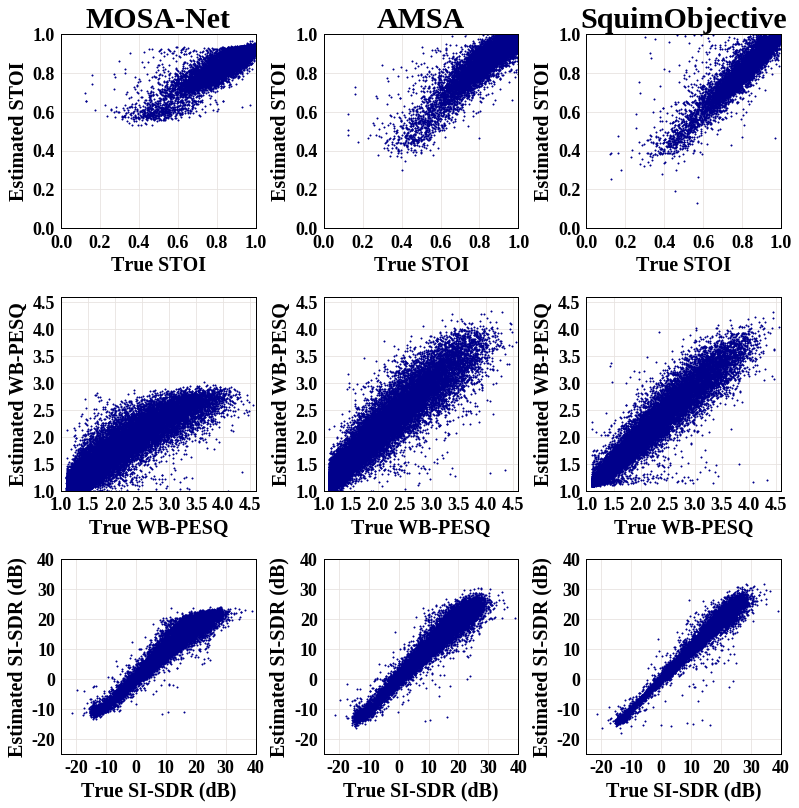
[1] Zezario, Ryandhimas E., Szu-Wei Fu, Fei Chen, Chiou-Shann Fuh, Hsin-Min Wang, and Yu Tsao. “Deep learning-based non-intrusive multi-objective speech assessment model with cross-domain features.” IEEE/ACM Transactions on Audio, Speech, and Language Processing 31 (2022): 54-70.
[2] Dong, Xuan, and Donald S. Williamson. “An attention enhanced multi-task model for objective speech assessment in real-world environments.” In ICASSP 2020-2020 IEEE International Conference on Acoustics, Speech and Signal Processing (ICASSP), pp. 911-915. IEEE, 2020.
下圖顯示了 SquimSubjective 模型的散點圖,其中 y 軸表示估計的 MOS 指標分數,x 軸表示對應的真實值。
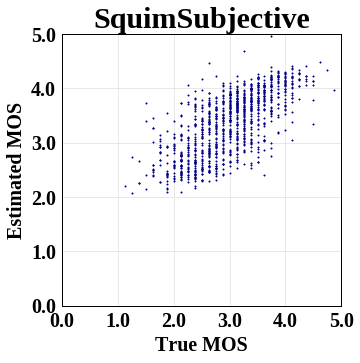
指令碼總執行時間: (0 分 14.618 秒)



